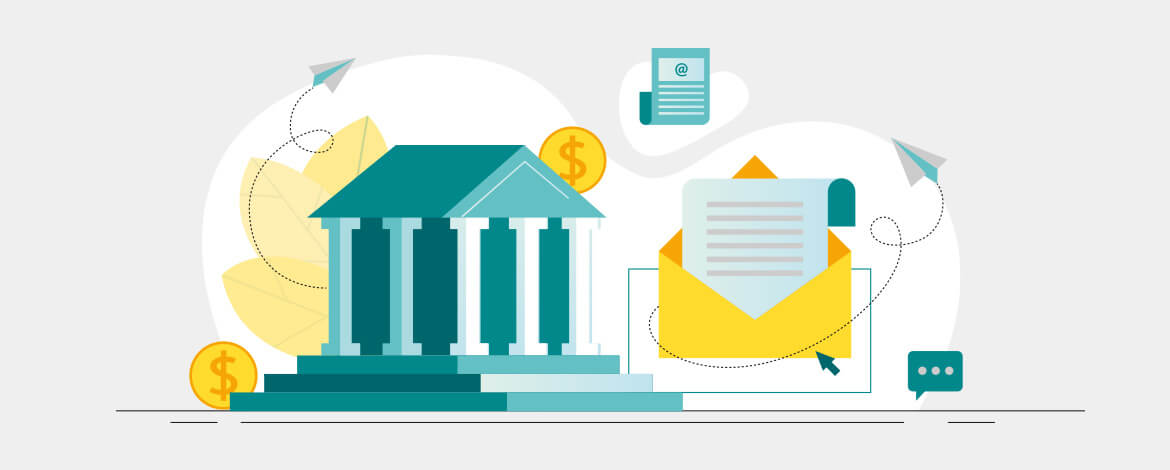Email marketing for the banking, financial services, and insurance (BFSI) industry does not work like conventional execution strategies of email marketing. Considering the high probability of phishing emails in this industry, marketers need to be extra vigilant about the kind of emails they send.
Today, banks and financial institutions are hit by around 12,000 unique monthly bank phishing email campaigns. It not only exploits their good names but also misleads the consumers and businesses. It is noticed that cybercriminals choose to impersonate banks or electronic payments providers 60% of the time. According to Original Agari Research, Bank of America and Wells Fargo were among the top ten impersonated brands in the last quarter of 2018.
Generally, phishing emails are fraud alerts, password resets, and account-locked notices that create a sense of urgency and alarm, encouraging the recipients to take instant action.
An example of a phishing email is shown below.
If you notice carefully, the ‘from name’ clearly portrays that the email is not sent by U.S. Bank. Also, the first line has punctuation errors and reputed banks would not send an email with such mistakes.
It is intriguing to know that email-based brand impersonation schemes are rising 400% every year. However, in such frauds and phishing scams, banks also have to pay a price just like the victims do. The financial damage and negative publicity generated by phishing emails hampers the reputation of the impersonated banks despite not being completely liable for the losses.
Therefore, the primary objective of banks and financial institutions should be to build trust and confidence with the prospects and customers. If you want to learn how to make your banking industry emails topnotch, we have some great tips for you.
1. Have a robust lead generation strategy
According to Digital Growth Institute, 87% financial brands fail to have a solid lead generation strategy driven by marketing automation. Financial brands are missing out on a huge opportunity by not harnessing the power of these strategies. Therefore, they should incorporate a double opt-in tactic to build a quality list of prospects.
Here’s a verification email from Coinbase that lets the user confirm their email address.
2. Establish the sender reputation by enforcing the deliverability standards
Domain-based Message Authentication, Reporting, and Conformance (DMARC) has turned out to be a sureshot tactic for banks and other brands to avoid impersonation scams. DMARC works as an open standard to ensure that except authorized senders, no one else can use the organization’s domain name in their emails. Phishing emails sent by fraudsters for impersonating brands reach almost zero, when this trick is incorporated correctly. Despite its effectiveness, only 13% of all financial institutions have implemented DMARC which means that 87% are still vulnerable to such phishing attacks.
3. Incorporate marketing automation and lead nurturing campaigns
It is quite natural that your subscribers might not be ready to buy from you as soon as they sign up. Financial products cannot be purchased impulsively and that’s the main reason for the long purchase cycle.
For example: Most people make the decision to purchase an insurance plan at least 2-3 months after they get to know about it.
Therefore, once you get a subscriber who is interested in your financial services, you can send nurturing emails and try to build a stronger relationship with them.
Through these emails, you should try to educate the subscribers about the services provided by your institution.
They should also let the recipient know how to recognize genuine emails from them and disclaimer to inform them about its confidentiality.
4. Mitigate the cyber security risks by taking proper privacy measures
If you are an email marketer from the banking industry, you should encrypt your communications by setting how and when to enable Transport Layer Security (TLS) for secure email delivery. Furthermore, encrypting the emails prevents sending the email to email providers not supporting an encrypted channel.
Banks and financial brands should make sure that the ESP vendors are ISO certified. ISO 27001 is among the most effective standards as it not only offers requirements for an information security management system (ISMS) that works as a systematic approach to handling confidential information and ensuring security.
5. Manage user rights well
Every professional should have varying degrees of access to data and permissions to the email marketing software. As an example, an email marketing manager should bear in mind that a copywriter or junior marketer can write email campaigns but they do not have access to customer-level data. Also, every email must have consistent branding and legal information that cannot be edited by users. The marketer should also see to it that functions like database field changes, or data in- and exports are not available to everyone, but only to those who need them. The email marketing software must be equipped with workflow management and quality assurance built-in. These features do not allow sending the email without an OK by the legal, compliance, or any other concerned department. Permission levels can vary according to the roles and can be modified based on their use of the platform.
6. Work on the technical aspects
While preparing for your banking industry email marketing, you must prepare a list of all your databases, MarTech, and legacy systems. The email marketing software you choose should be able to integrate all these systems and work in complete sync with each other.
Wrapping Up
Imparting a pleasant customer experience is the basis of email marketing, but when it comes to banking and financial brands, it is also important to render a safe experience for the subscribers and help them differentiate between genuine and fake. These six tips shared here would surely make your email marketing better, safer, and more effective for the users.






Disha Bhatt (Dave)
Latest posts by Disha Bhatt (Dave) (see all)
SFMC: Creating customer-centric experiences in real-time
How Salesforce Marketing Cloud Can Help You Deal with Marketing Challenges